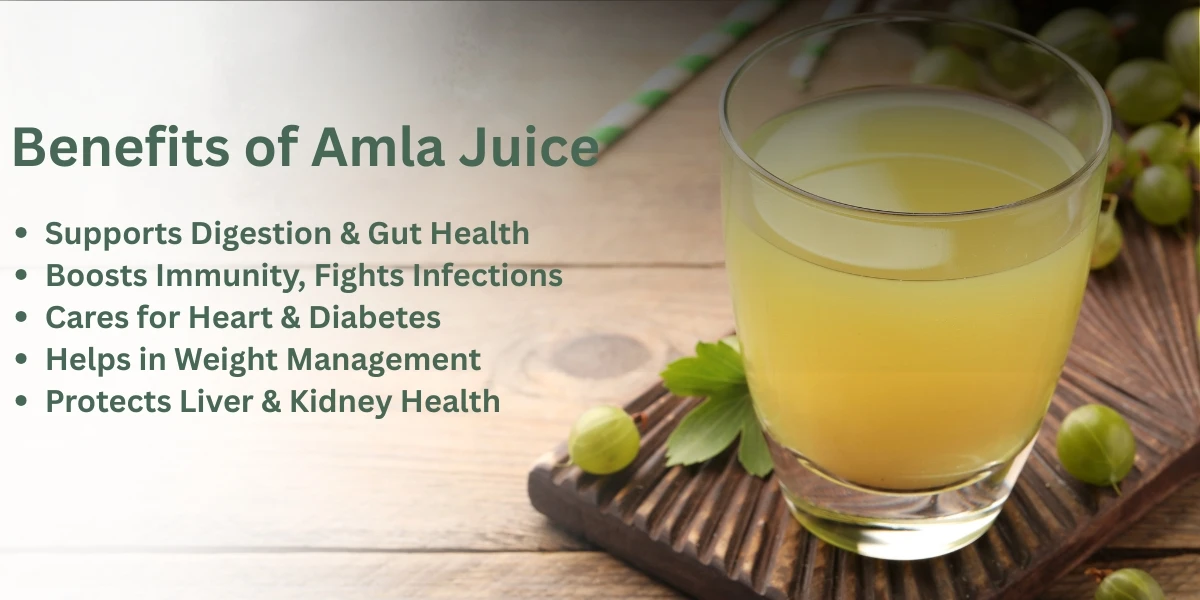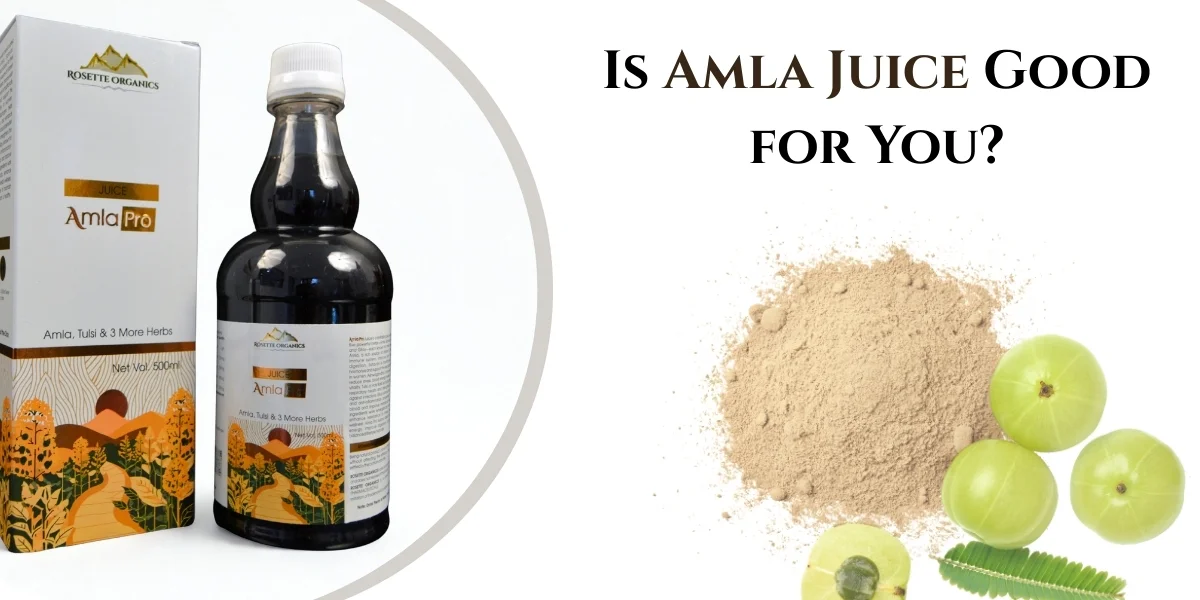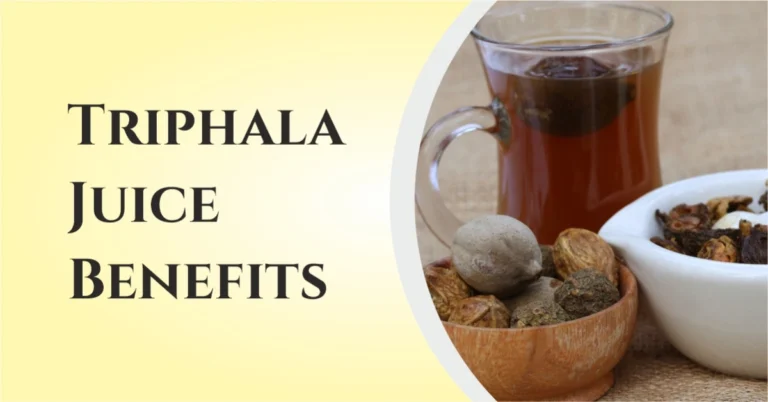Is Amla Juice Good for You? Dosage, Side Effects & Best Health Hacks
In 2025, amla juice has become one of the most talked-about natural health drinks. While it has always held a strong place in Ayurveda, today it is crossing into mainstream wellness because people are looking for remedies that are both traditional and science-backed.
Amla, also known as Indian gooseberry, is loaded with vitamin C, antioxidants, and phytonutrients that help the body fight stress, build immunity, and stay youthful. With growing focus on natural detox, skin glow, and weight balance, more people now see amla juice as an everyday superfood rather than a seasonal home remedy.
Another reason for its popularity is that it’s affordable and easy to use compared to other global superfoods. You can buy it ready-made, prepare it fresh at home, or mix it with honey, aloe vera, or ginger for better taste and added benefits. This makes it fit well into different lifestyles—whether someone wants a morning detox shot, a beauty tonic, or a daily wellness booster.
The blend of cultural heritage and modern research is what sets amla juice apart in 2025. It carries the trust of Ayurveda while aligning with today’s health goals, making it a natural choice for people searching for simple yet powerful ways to stay healthy.
Nutritional Profile of Amla Juice
What makes amla juice stand out as a wellness drink is not just its taste but the rich nutrient package it carries. Every sip is loaded with compounds that work together to support immunity, digestion, and overall vitality. Scientists and Ayurvedic experts agree that the power of amla lies in its unique mix of vitamins, minerals, antioxidants, and bioactive compounds.
- Vitamin C & Antioxidants – Amla is one of the richest natural sources of vitamin C, which boosts immunity and fights cell damage. Its antioxidants like flavonoids protect the body from oxidative stress and slow down ageing.
- Polyphenols, Gallic Acid & Ellagic Acid – These plant compounds have strong anti-inflammatory and protective roles. They help maintain heart health, balance blood sugar, and improve skin repair.
- Fiber, Minerals & Micronutrients – Amla juice contains dietary fiber that aids digestion, plus minerals like calcium, iron, and phosphorus that keep bones, blood, and energy levels in check.
- Ayurvedic Attributes – In Ayurveda, amla is described as sour, astringent, and bitter in taste (Rasa), with a cooling potency (Virya), and a sweet post-digestive effect (Vipaka). It is believed to balance all three doshas—Vata, Pitta, and Kapha—making it a rare tridoshic fruit.
Together, these nutrients and attributes explain why amla juice is often called a natural rejuvenator. It is not just another fruit drink but a complete blend of modern nutrition and Ayurvedic wisdom.
Benefits of Amla Juice

Supporting Digestion & Gut Health
Amla juice gently supports digestion. Its natural acids and fiber help stimulate enzymes, reduce bloating, and keep bowel movements regular. Many people find it soothing when taken diluted before or between meals.
- May ease gas and acidity when diluted.
- Can support a healthier gut environment.
Boosting Immunity & Fighting Infections
Rich vitamin C and plant antioxidants in amla juice help the body defend itself. Regular intake can support the immune response and reduce oxidative stress that weakens natural defenses.
- Antioxidants help neutralize free radicals.
- Works well as a daily wellness add-on.
Heart, Cholesterol & Diabetes Management
Compounds in amla juice are linked to better lipid balance and insulin sensitivity. When paired with diet and exercise, it may help support healthy cholesterol and more stable blood sugar.
- May assist in maintaining LDL and triglycerides within range.
- Can complement lifestyle measures for glucose control.
Weight Management & Detox Effects
Low in calories yet nutrient-dense, amla juice fits easily into weight goals. It may curb cravings, support metabolism, and promote gentle detox through better digestion and hydration.
- Light, easy to add to morning routines.
- Works well in diluted form or smoothies.
Liver & Kidney Protection
Amla’s antioxidant and anti-inflammatory activity may help protect liver cells and support normal detox pathways. Hydrating, diluted amla juice can also complement kidney wellness routines.
- May assist normal liver enzyme balance.
- Supports overall cellular protection.
Traditional Ayurvedic Rasayana Role
In Ayurveda, amla is a classic rasayana—a rejuvenator that nourishes tissues and supports longevity. It is considered tridoshic, meaning it helps balance Vata, Pitta, and Kapha when used appropriately.
- Cooling (sheetala) nature makes it suitable in warm seasons.
- Often used as a daily tonic within balanced diets.
Amla Juice for Hair Health

Stimulating Growth & Thickness
- Supports stronger roots with natural antioxidants and vitamin C
- Helps scalp circulation when used as a light rinse or in hair masks
- Works well with protein-rich diets to support keratin
Amla juice can be sipped (diluted) or used topically. For topical use, mix amla juice with aloe vera gel (1:1), apply to scalp for 20–30 minutes, then rinse. For drinking, dilute 15–30 ml amla juice in 150–200 ml water, 3–5 days a week.
Preventing Hair Fall
- Antioxidants help reduce oxidative stress around follicles
- Vitamin C supports iron absorption, which is linked to less shedding
- Gentle astringent action can make strands feel stronger
Pair amla juice with adequate protein (dal, paneer, eggs) and minerals in meals. Use a light scalp massage with diluted amla juice before wash days to reduce breakage from tugging.
Controlling Dandruff & Scalp Infections
- Naturally acidic pH helps balance an oily, flaky scalp
- Plant compounds show antimicrobial activity in lab settings
- Blends well with neem or tea tree (few drops) in a pre-wash mask
Dab diluted amla juice on the scalp (avoid broken skin). Leave for 10–15 minutes, then shampoo. Always patch test behind the ear first to avoid irritation.
Slowing Premature Greying
- Antioxidants may help protect pigment cells from oxidative stress
- Traditional use pairs amla with oils to nourish the scalp
- Works best as a long-term routine, not a quick fix
Warm a few teaspoons of amla-infused oil or mix a little amla juice into your regular hair oil. Massage gently and leave overnight once or twice a week, then wash as usual.
Amla Juice for Skin & Beauty
Amla juice is not only valued for health but also for its role in natural beauty care. Its vitamin C, antioxidants, and cooling nature make it a popular choice for keeping skin clear, youthful, and balanced. Whether consumed or applied, it supports skin from inside and outside.
- Acne & Pimple Support: Diluted amla juice can be dabbed on problem spots with cotton; drink small amounts regularly to help reduce breakouts.
- Natural Glow & Anti-Ageing Properties: Mix 2 teaspoons of amla juice with honey and drink in the morning; for topical use, blend amla juice with rose water and apply as a toner for fresh glow.
- Pigmentation & Sun Damage Care: Apply a thin layer of amla juice mixed with aloe vera gel to soothe tanning; consuming diluted juice helps improve skin tone over time.
- DIY Face Packs & Topical Mixes: Amla juice + multani mitti (Fuller’s earth) for oily skin; amla juice + yogurt for hydration; amla juice + turmeric for dull skin.
How to Consume Amla Juice (Dosage & Methods)
Amla juice works best when you match timing, dose, and form to your goal and tolerance. Start low, dilute well, and build a steady routine rather than taking large amounts at once.
Best Time to Drink (Morning Detox, Pre-Meal Digestion, Bedtime Skin Repair)
For most people, the easiest start is morning on an empty stomach—well diluted—followed by plain water if needed. If you have acidity, shift to post-breakfast. For digestion, a small pre-meal serving can help you feel lighter. For skin routines, a light evening serving pairs well with good hydration and sleep.
- Morning detox: Diluted amla juice soon after waking; wait 15–20 minutes before eating.
- Pre-meal digestion: A small, well-diluted serving 15 minutes before your heaviest meal.
- Bedtime skin repair: A very small serving after dinner if tolerated; avoid if it disturbs sleep or causes acidity.
Ideal Daily Dosage (ml, tbsp, diluted vs concentrated)
- Beginners (ready-to-drink juice): 10–15 ml mixed in 150–200 ml water, once daily.
- Standard routine: 15–30 ml in 150–250 ml water, once daily; split into two smaller servings if preferred.
- Concentrate/extract: Check label potency; typically 5–10 ml concentrate in 200–250 ml water.
- Sensitive stomach: Always take after food and increase dilution (e.g., 10 ml in 250–300 ml water).
- Maximum practical range: Usually not more than 30 ml/day of regular juice for most adults unless advised by a professional.
- Teens & older adults: Start at the lower end (5–10 ml), assess tolerance, then step up slowly.
- Medical conditions/meds (e.g., diabetes, pregnancy, kidney issues): Consult your clinician before use and monitor tolerance.
Amla Juice vs Raw Amla vs Powder
| Aspect | Amla Juice | Raw Amla (Whole) | Amla Powder (Churna) |
|---|---|---|---|
| Typical Dose | 15–30 ml/day (diluted) | 1–2 fresh fruits/day | ½–1 tsp (2–3 g) in water/yogurt |
| Vitamin C | High; varies by brand & processing | Very high when fresh | Moderate; can reduce with storage |
| Ease of Use | Very easy; quick to drink | Prep needed; taste is sharp | Easy; mixes into water or smoothies |
| Taste | Sour/astringent; improved with honey/ginger | Very sour/astringent | Sour/astringent; more neutral in mixes |
| Absorption | Fast (liquid) | Good (whole food matrix) | Good; depends on mixing & timing |
| Cost | Moderate per shot | Low (seasonal) | Low to moderate (economical) |
| Best For | Daily routine, quick use | Whole-food nutrition | Smoothies, travel, year-round backup |
How to Prepare Amla Juice at Home (Step-by-Step Recipe)
- Wash & prep: Rinse 4–5 fresh amlas; deseed and chop.
- Blend: Add ½–1 cup cold water; blend to a smooth puree.
- Strain (optional): Use a fine sieve/muslin to remove pulp if you prefer clear juice.
- Dilute to serve: Mix 30–50 ml of the fresh extract with 200–250 ml water.
- Taste balance (optional): Add a squeeze of lemon, a few drops of ginger juice, or honey to soften the sharp taste.
- Use fresh: Drink immediately or refrigerate for up to 24 hours; vitamin C is sensitive to time, heat, and air.
- Note for sensitive stomachs: Take after food and increase dilution; avoid very cold or very concentrated servings.
Side Effects & Safety of Amla Juice
Empty Stomach Effects – Safe or Risky?
Amla juice on an empty stomach can work as a detox, but for some it may trigger acidity, cramps, or nausea. If you feel discomfort, take it after meals and always dilute well. Rinse your mouth to protect teeth from acidity.
Common Side Effects (Acidity, Stomach Upset)
- Acidity or heartburn if taken undiluted
- Loose motions or stomach upset with high doses
- Rare allergic reactions like itching or rash
Who Should Avoid (Pregnancy, Diabetes meds, Kidney conditions)
- Pregnant or breastfeeding women: consult a doctor first
- Diabetics on medication: monitor sugar to avoid hypoglycemia
- Kidney stone history: use cautiously, due to vitamin C and oxalate link
Safe Limits & Drug Interactions
Stay within 15–30 ml/day (diluted) unless advised otherwise. Avoid combining with other acidic supplements. Use caution with diabetes or thyroid medicines, as timing and dosage may need adjustment.
Amla Juice Recipes & Health Hacks
Amla juice doesn’t have to taste sharp or boring. With a few smart combinations, it can become refreshing, soothing, and even enjoyable. These quick ideas make it easier to add amla juice into daily routines for both taste and health.
- Amla + Aloe Vera for Skin & Gut: Mix 20 ml amla juice with 20 ml aloe vera juice in 200 ml water; drink in the morning to soothe digestion and support skin hydration.
- Amla + Ginger + Tulsi for Cold/Flu: Blend 15 ml amla juice, a few drops of ginger juice, and 4–5 fresh tulsi leaves in warm water; sip slowly to ease congestion.
- Amla Juice with Honey (Soothing Immunity Booster): Stir 15 ml amla juice with 1 teaspoon honey in lukewarm water; take mid-morning for a gentle immunity lift.
- Quick DIY Smoothies & Summer Coolers: Add 20 ml amla juice to coconut water with mint for a cooler, or blend with mango/banana and yogurt for a tangy smoothie.
FAQs
What are the main health benefits of drinking amla juice?
Amla juice supports immunity, digestion, heart health, and metabolism. It is also linked to better skin glow, hair strength, and overall detox because of its high vitamin C and antioxidants.
How much amla juice should I drink daily?
Most adults can take 15–30 ml diluted in 150–250 ml water once a day. Beginners or sensitive stomachs should start with 5–10 ml diluted and increase slowly.
What is the best time to drink it?
The common choice is morning on an empty stomach for detox. If you have acidity, shift to after meals. For digestion, a small pre-meal serving works well.
Can amla juice help hair & skin?
Yes. Its vitamin C and antioxidants help reduce hair fall, support growth, and improve scalp health. For skin, it promotes natural glow, slows ageing, and can reduce acne or pigmentation when taken regularly.
Are there side effects if I drink too much?
Excess intake can cause acidity, loose motions, stomach cramps, or nausea. Rarely, some people may have allergic reactions. Stick to safe limits and always dilute.
Is it safe for pregnant women or diabetics?
Pregnant or breastfeeding women should consult a doctor first. Diabetics on medication should monitor blood sugar closely, as amla may lower glucose further and interact with medicines.
How can I make amla juice at home?
Wash 4–5 fresh amlas, deseed, and chop. Blend with ½ cup water into a smooth puree, strain if needed, and dilute 30–50 ml of the extract in 200–250 ml water. Add honey, ginger, or lemon for taste. Consume fresh or store for up to 24 hours in the fridge







